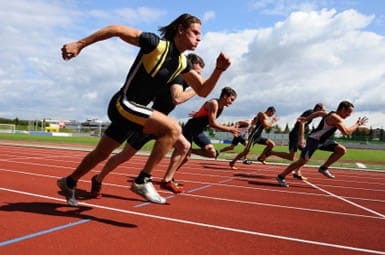GIVEN the nature of sport, it is no surprise that injuries and accidents happen. In fact, it may be a surprise that more injuries and incidents do not occur. The fast paced nature of sport and the high contact nature of some activities mean that there is an element of risk involved with many sports. This is why it is important for as many people involved with sport to know about first aid and how to properly react to the many different injuries that can occur in sport. Whether it is actually tending to an injury or ensuring people are comfortable and don’t worsen their injuries before proper medical attention can be implied, it is important to know what best to do to ensure that people are well looked after.
There are lots of different injuries that can arise when playing sport so it is important to have a broad range of skills. A coach or team manager should always have access to a first aid kit and they should know what to do with it. The majority of injuries that occur in sport will be bruises or stresses. This means that the vast majority of injuries to respond to on a sports field will be based around prevention, stopping or reducing swelling. If the injury affects soft tissue, it can swell or it can be damaged internally. This can lead to pain, it can result in a loss of motion and if not checked, it can limit a person’s use of their muscles. When we talk about muscle injuries, it is also worth noting that prevention tactics are very important. The stronger and fitter you are, and the more you try and keep in shape and allow amino acids to build your muscle, the more prepared you will be for whatever activity. And, you may be far less likely to get injured in the first place
When dealing with a soft tissue injury, the standard reaction is to use the PRICE method, which stands for Protection, Rest, Ice, Compression and Elevation.
Follow the PRICE method to deal with sporting injuries
The Protection element means stopping playing or training immediately and then ensuring that the injured part will not be placed at any more risk of injury. The Rest element means that the affected area must be allowed time to recover and heal. The Ice element, understandably, revolves around cold therapy with an ice pack or even a bag of frozen peas being applied to the injury. This is a good way to narrow your blood vessels which can help to reduce the risk of blood loss.
The compression element sees pressure being applied to or around the injured area and this will help to reduce the risk of further swelling. If possible the Ice and Compression elements should be used at the same time. The final element is Elevation, where the injured areas should be raised as this will further help to minimise the swelling and flow of blood to the injured area.
If someone receives a sporting injury which leads to a cut or an abrasion, there is a need to stop the flow of blood as quickly as possible. After this, the open wound should be cleaned as effectively as possible and then a proper cover, such as a sticking plaster or a bandage should be placed across the cut. If the cut is a minor one that is under control it can be resolved without professional assistance but if the flow of blood continues or the cut remains open, seeking professional assistance makes sense. A deep cut is likely going to require to be stitched so you should visit a hospital or doctor.
If the injury is more of a nagging and insistent injury as opposed to something that occurs from one incident or move, it is important to rest the injury or seek out professional assistance. It may be physiotherapy is required and is the best way to resolve the issue over the longer term. It may also be that medication is required as part of the rehabilitation practice to ensure that you get back on your feet.
Sports injuries can prevent you from being happy and enjoying your sport but knowing how best to deal with injuries can ensure you get more enjoyment from your sporting activity.













